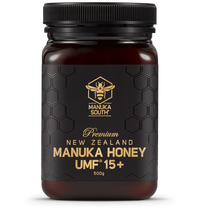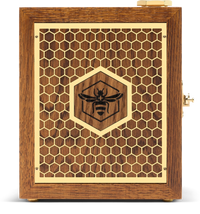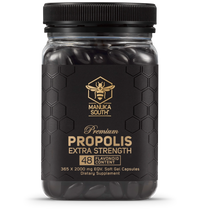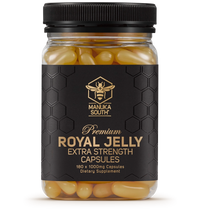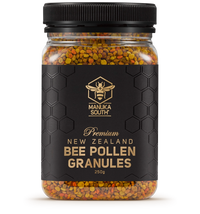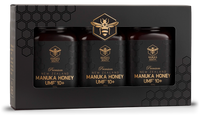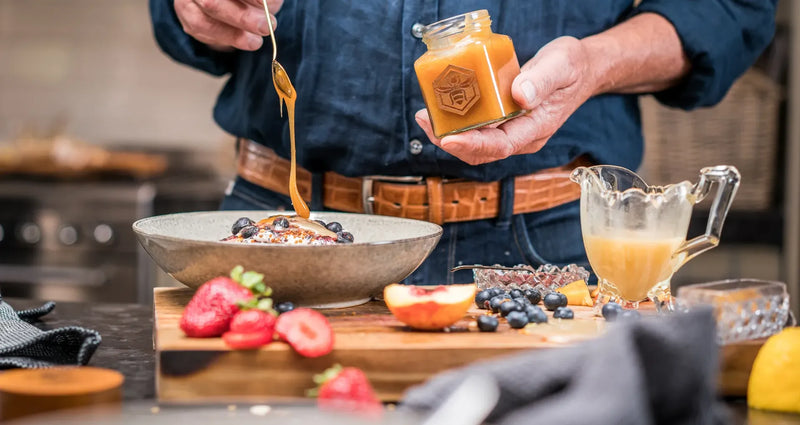

Navigating the world of Manuka Honey can be a bit like stepping into a lush, intricate garden for the first time. You know there's something extraordinary here, but understanding what makes each variety special can be overwhelming.
That's where grading systems like UMF, MGO, and others come into play. These aren't just random letters or marketing jargon; they're your roadmap to understanding the quality, potency, and authenticity of the Manuka Honey you're considering. Whether you're a long-time aficionado or a curious newcomer, understanding these grading systems is crucial. They help you discern the strength and benefits of each jar, ensuring you get exactly what you're looking for—be it for health, taste, or both. So, let's delve into this fascinating world together and unravel what these grades really mean for your jar of liquid gold. Trust me, it's a journey worth taking.
Authentic Manuka Honey Grading Systems

UMF (Unique Manuka Factor)
Ah, UMF—these three letters are often the first thing you'll see when you're eyeing a jar of Mānuka Honey. But what do they really mean? UMF, or Unique Mānuka Factor, is more than just a label; it's a quality assurance mark that tells you you're getting genuine, high-quality Manuka Honey from New Zealand.
What is UMF?
UMF is a comprehensive measure that takes into account various natural compounds found in Mānuka Honey, such as Methylglyoxal (MGO), Leptosperin, and Dihydroxyacetone (DHA). These compounds are the heroes behind Mānuka Honey's much-touted health benefits, from its antibacterial properties to its potential to boost your immune system.
How is UMF Measured?
Now, you might be wondering, "How do they come up with the UMF number on the jar?" Well, it's not pulled out of thin air. The UMF grading system is backed by rigorous scientific research. Each batch of Mānuka Honey undergoes stringent testing in independent laboratories to determine its UMF rating. The higher the UMF number, the greater the concentration of beneficial compounds, making it more potent and, often, more expensive.
Components Involved in UMF Grading
Let's get a bit technical, but stay with me. The UMF rating is derived from the concentration of MGO, Leptosperin, and DHA. MGO is particularly important as it's the compound mainly responsible for the honey's antibacterial properties. Leptosperin and DHA are also crucial, serving as markers for the authenticity and quality of the honey.
UMF Rating Scale and Its Significance
The UMF rating scale starts at UMF 5+ and goes all the way up to UMF 32+. Each level indicates a specific concentration of MGO and other compounds. For instance, UMF 10+ means the Manuka honey contains at least 263 mg of MGO per kg. The higher the number, the stronger the honey. So, whether you're looking for a daily health supplement or a potent remedy, there's a UMF rating that's just right for you.
Read More:
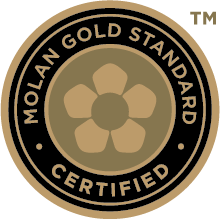
MGS (Molan Gold Standard)
The Molan Gold Standard, often abbreviated as MGS, is named after Dr. Peter Molan, a biochemist who was instrumental in discovering the unique properties of Manuka Honey. This grading system serves as a tribute to his groundbreaking work and aims to set a high standard for Mānuka Honey quality.
What is MGS?
The Molan Gold Standard is a certification that assures you're getting Manuka Honey that meets stringent quality and purity criteria. It's a mark of authenticity, guaranteeing that the honey is sourced from New Zealand and contains a certain level of Methylglyoxal (MGO), the compound responsible for Mānuka Honey's antibacterial properties.
How is MGS Measured?
MGS is measured based on the concentration of MGO in the honey. The rating is usually expressed in a format similar to MGO, such as MGS 100, which would indicate an MGO concentration of 100 mg per kg. This ensures that consumers can easily understand the potency of the honey they're purchasing.
Components Involved in MGS Grading
The MGS grading system focuses primarily on the MGO levels but also takes into account other factors like purity, authenticity, and ethical sourcing. This makes it a well-rounded grading system that not only assures potency but also guarantees that the honey is responsibly sourced and free from adulteration.
MGS Rating Scale and Its Significance
The MGS rating scale is straightforward and closely aligned with the MGO scale. It starts at MGS 30 for general well-being and can go up to MGS 550 or higher for specific therapeutic uses. The higher the MGS rating, the more potent the antibacterial properties of the honey.
Flawed Manuka Honey Grading Systems
KFactor
KFactor is a term you might stumble upon when you're exploring Manuka Honey, it is a system created and used only by Wedderspoon Organic to determine the purity of mānuka honey. However, KFactor does not measure the antibacterial strength of the Manuka honey. It instead simply measures what pollen percentage of the honey came from Manuka flowers.
What is KFactor?
KFactor is a system that tracks five "Key Factors" to guarantee a honey is:
- Raw & Unpasteurized
- Non-GMO Verified
- Produced and Packed in New Zealand
- Free of Antibiotics, Glyphosate and Pesticides
- Traceable from Hive to Home
BioActive
While shopping for Manuka Honey, you might come across jars labelled as "BioActive." It's essential to approach these labels with caution. Unlike grading systems like UMF and MGO, which offer a more reliable measure of the honey's antibacterial properties, the term "BioActive" can be misleading.
BioActive is a term that refers to both the peroxide and non-peroxide activity of the honey. However, hydrogen peroxide activity degrades quickly when exposed to fluids like saliva, heat, and sunlight, making it an unreliable measure of the honey's antibacterial properties.
Why You Should Be Cautious
The official Manuka Honey of NZ website advises consumers to avoid honey labelled with "Active" or "BioActive." These labels can be misleading and are unlikely to offer the specific antibacterial benefits that Manuka Honey is known for.
What to Look for Instead
If you're seeking the health benefits of Manuka Honey, it's advisable to opt for jars that are graded with more reliable systems like UMF or MGO. These grading systems provide a more accurate measure of the honey's antibacterial potency and are backed by scientific research.
Mistaken Manuka Honey Grading Systems

These methods aren't actual grading systems but instead measurements of a single compound within the honey.
MGO (Methylglyoxal)
If UMF is the all-encompassing measure of Manuka Honey's quality, MGO zeroes in on one specific compound: Methylglyoxal. This naturally occurring compound is the star player in Manuka Honey's lineup of health benefits. It's what gives this unique honey its antibacterial, antiviral, and anti-inflammatory properties.
What is MGO?
MGO stands for Methylglyoxal, a compound found in varying concentrations in Manuka Honey. While MGO is present in other types of honey, its levels in Manuka Honey are exceptionally high, thanks to the nectar of the Manuka flower. The higher the MGO level, the more potent the honey's antibacterial properties.
How is MGO Measured?
Measuring MGO is a precise science. It's quantified in milligrams per kilogram (mg/kg) of honey. So when you see a jar labeled with MGO 400+, it means that there are at least 400 mg of Methylglyoxal per kilogram of that honey. This number is determined through lab tests, ensuring you get exactly what's promised on the label.
The Role of MGO in Manuka Honey
MGO is the powerhouse behind Manuka Honey's ability to fight off bacteria and boost your immune system. It's the reason why Manuka Honey is often recommended for wound care, digestive issues, and even as a natural remedy for infections. However, it's essential to note that while MGO is a crucial factor, it's not the only one. Other compounds like Leptosperin and DHA also contribute to the honey's overall efficacy.
MGO Rating Scale and Its Significance
The MGO rating scale is straightforward. It starts at around MGO 30 and can go up to MGO 1000 or more. The higher the number, the more potent the antibacterial properties. For example, an MGO rating of 100+ is suitable for general well-being, while an MGO 550+ would be considered highly potent and more suitable for specific therapeutic uses.
Read More:
NPA (Non-Peroxide Activity)
NPA stands for Non-Peroxide Activity, and it's a grading system that zeroes in on one of the most unique aspects of Manuka Honey: its ability to retain antibacterial properties even when hydrogen peroxide activity is neutralized. This makes NPA a fascinating and important measure to consider. However, this is also not a grading system, but a measurement of one compound in Mānuka Honey.
What is NPA?
Non-Peroxide Activity is a measure of Manuka Honey's antibacterial potency that is not derived from hydrogen peroxide. Most honeys have some level of antibacterial activity due to hydrogen peroxide, which is naturally formed in honey. However, Manuka Honey has additional, more stable antibacterial components, which are measured by the NPA rating.
How is NPA Measured?
NPA is usually expressed as a percentage, which represents the honey's antibacterial efficacy compared to a phenol standard. For example, an NPA rating of 10% would indicate that the honey's antibacterial activity is equivalent to a 10% phenol solution. This rating is determined through lab tests that measure the honey's ability to inhibit bacterial growth.
Components Involved in NPA Grading
NPA focuses on the non-peroxide antibacterial activity in Manuka Honey, which is primarily due to the presence of Methylglyoxal (MGO). However, other compounds like Leptosperin may also contribute to the honey's NPA rating.
NPA Rating Scale and Its Significance
The NPA rating scale typically ranges from 5+ to 20+, with higher numbers indicating greater antibacterial activity. An NPA rating of 5+ is good for general health maintenance, while higher ratings like 15+ or 20+ are more suitable for therapeutic uses.
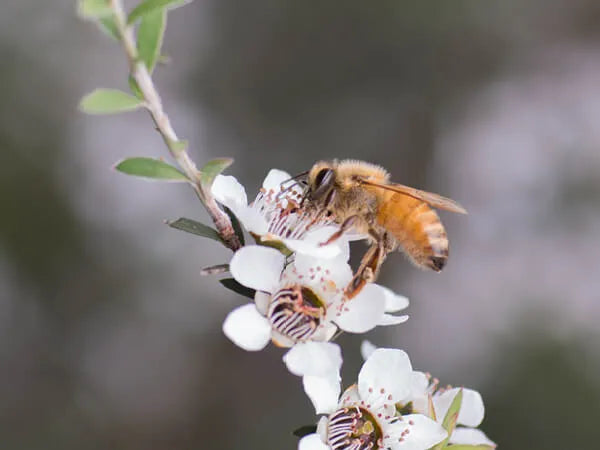

Monofloral vs Multifloral Manuka Honey
When you're scanning Manuka Honey labels, you'll often come across the terms "Monofloral" and "Multifloral." While they might seem like botanical jargon, understanding these terms can actually help you make a more informed choice.
What are Monofloral and Multifloral Manuka Honey?
Monofloral Manuka Honey is sourced from bees that primarily collect nectar from the Mānuka flower. This results in honey with a higher concentration of Manuka-specific compounds like Methylglyoxal (MGO). On the other hand, Multifloral Manuka Honey is derived from bees that forage on a variety of flowers, including but not limited to Mānuka. This results in a more diverse range of compounds, but often with lower concentrations of Mānuka-specific elements.
How are They Different?
The primary difference lies in the concentration of Manuka-specific compounds. Monofloral Mānuka Honey generally has higher levels of MGO and other Manuka-specific compounds, making it more potent and often more expensive. Multifloral Manuka Honey, while still beneficial, may offer a broader range of nutrients due to the variety of floral sources but will generally have lower Mānuka-specific activity.
Regulatory Aspects
When it comes to M Manuka vvānuka Honey, not all jars are created equal. That's why it's essential to understand the regulations that help maintain the integrity and quality of this unique product. After all, when you're investing in a jar of Mānuka Honey, you want to be sure you're getting what you pay for.
New Zealand Government Regulations
The New Zealand government has set strict guidelines to regulate the production and labelling of Manuka Honey. These regulations ensure that any honey labelled as "Manuka" meets specific criteria, including the concentration of key compounds like Methylglyoxal (MGO) and Leptosperin. This is a crucial step in preserving the reputation and quality of Mānuka Honey, especially as its popularity continues to soar globally.
Importance of Certification
Certifications like UMF, MGO, and others are not just marketing tools; they're a way to ensure quality and authenticity. These certifications are backed by rigorous testing and independent audits, providing an extra layer of assurance for consumers. So when you see these labels, you can feel confident that you're getting a high-quality product.
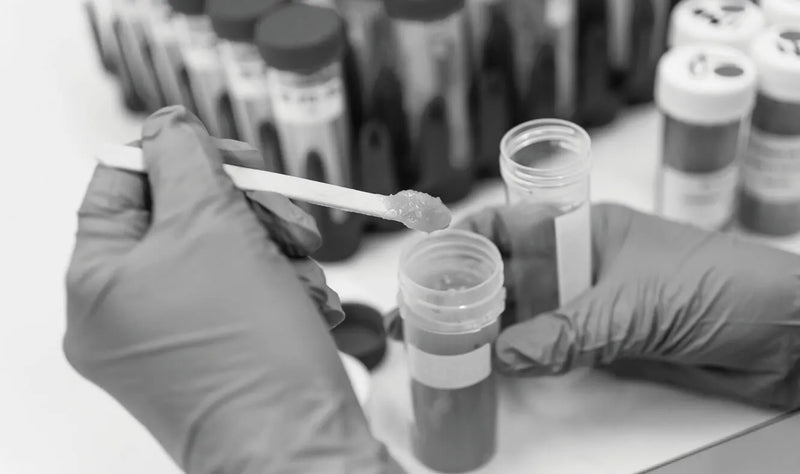

Manuka Honey Grades Comparison
| UMF | MGS | KFactor* | BioActive* | MGO** | NPA** |
|---|---|---|---|---|---|
| 5+ | 5+ | - | - | 83 | 5+ |
| 10+ | 8+ | - | - | 263 | 10+ |
| 15+ | 15+ | - | - | 514 | 15+ |
| 20+ | 20+ | - | - | 829 | 20+ |
| 24+ | 25+ | - | - | 1122 | - |
| 26+ | - | - | - | 1282 | - |
| 28+ | - | - | - | 1450 | - |
| 32+ | - | - | - | 1804 | - |
- KFactor and BioActive are misleading grading systems as they don't measure the anti-microbial factors of Manuka Honey.
- MGO and NPA aren't grading systems but measurements of markers in the honey, but are reasonable measurements to determine the quality of Manuka Honey. This table shows which levels are of the approximate UMF rating.
Navigating the world of Manuka Honey can feel like a journey through a labyrinth of letters and numbers. But once you understand the grading systems, these become signposts guiding you to the perfect jar. Whether you're seeking Manuka Honey for its taste, health benefits, or both, knowing how to interpret UMF, MGO, KFactor, and other grading systems can make all the difference. It empowers you to make informed choices, ensuring you get the most out of this liquid gold. So the next time you find yourself standing in front of a shelf full of Manuka Honey jars, you'll know exactly what to look for. Happy honey hunting!


